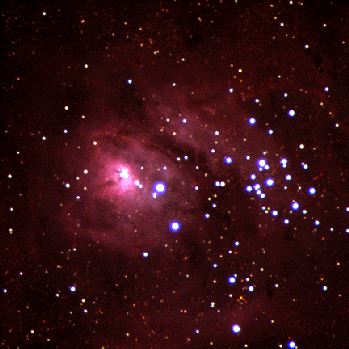Credit & Copyright: The
Electronic Universe Project
Explanation:
The large majestic
Lagoon Nebula
is home for many
young stars and
hot gas.
The Lagoon
Nebulae is so large and bright it can be seen without a telescope.
Formed only several million years ago in the nebula is the
open cluster known as NGC 6530, whose
young stars show their high temperature by
their blue glow. The nebula, also known as
M8 and NGC 6523, is named
"Lagoon"
for the band of dust seen to the left of the open cluster's center.
A bright knot of gas and dust in the nebula's center is known as the
Hourglass
Nebula. Star formation continues in the the
Lagoon
Nebula as witnessed by the many
globules that exist there.
1999 2000 2001 2002 2003 2004 2005 2006 2007 2008 2009 2010 2011 2012 2013 2014 2015 2016 2017 2018 2019 2020 2021 2022 2023 2024 2025 |
Январь Февраль Март Апрель Май Июнь Июль Август Сентябрь Октябрь Ноябрь Декабрь |
NASA Web Site Statements, Warnings, and Disclaimers
NASA Official: Jay Norris. Specific rights apply.
A service of: LHEA at NASA / GSFC
& Michigan Tech. U.
|
Публикации с ключевыми словами:
M 8 - open cluster - Рассеянное скопление - звездообразование - туманность - Межзвездная пыль
Публикации со словами: M 8 - open cluster - Рассеянное скопление - звездообразование - туманность - Межзвездная пыль | |
См. также:
Все публикации на ту же тему >> | |
